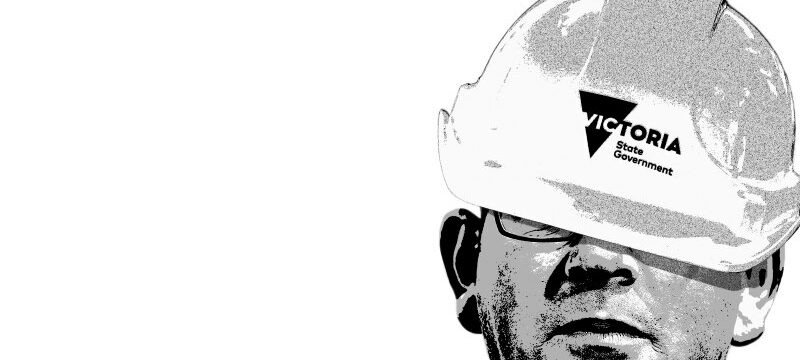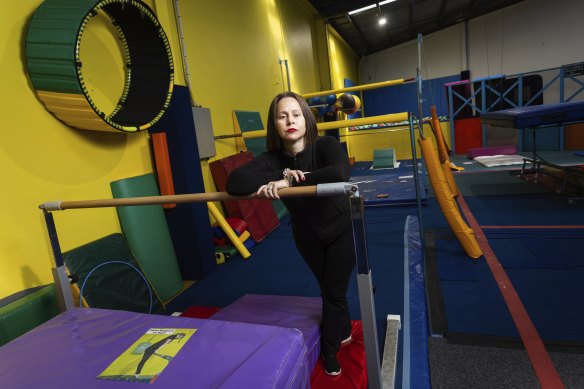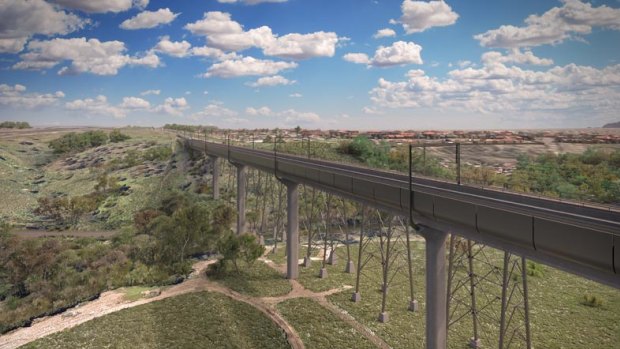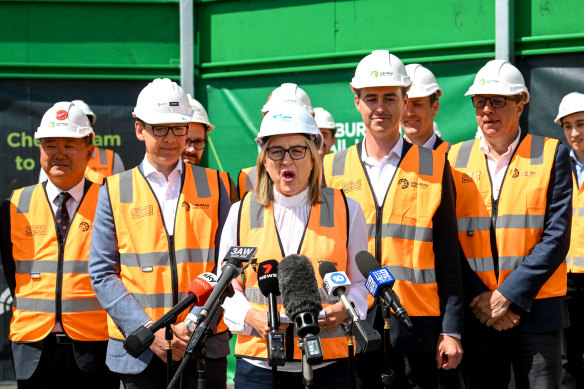Save articles for later
Add articles to your saved list and come back to them any time.
Christy Hemphill had made peace with the fact that the Melbourne Airport Rail line would bulldoze her gymnastics school in Airport West to make way for a train station.
The owner of Essendon Keilor Gymnastics Academy decided to “turn lemons into lemonade” by opening a bigger and better studio, after learning in early February her business of 18 years would be compulsorily acquired as soon as September 2024.
Christy Hemphill had just made an offer on a block of land to move her gym when she learnt the Melbourne Airport Rail would be delayed. Credit: Paul Jeffers
“We almost got excited about what a new location could bring,” Hemphill says. “We found a block of land and literally put an offer in on Saturday morning and were about to go ahead.”
Footpaths are already being dug up in Keilor East as part of works on the airport project. But by late afternoon Hemphill started to see reports that the long-awaited $13 billion Airport Rail project may be paused, bringing her own plans to a shuddering halt.
“We’ve got sometimes 2000 students coming through the club a week, so trying to find new premises that suit us is going to take a long time,” Hemphill says. “But the government won’t release funds for us to find a new location until they know it’s definitely going ahead. We’re all in the dark.”
A concept image of part of the Maribyrnong River Bridge, planned to be part of the Melbourne Airport Rail project.
Hemphill wasn’t the only one suffering whiplash. State MPs were blindsided by news the airport train – discussed for over half a century – would be delayed up to four years, stretching its completion date to 2033. The Andrews government also signalled that it intends to abandon the $4 billion Geelong fast rail project.
The uncertainty has cast doubt over other long-awaited public transport upgrades in Melbourne’s booming west that hinge on those two projects: the new Keilor East station, Sunshine and Albion station upgrades, and an extension of Metro train services through to Melton and Wyndham Vale.
Deputy Premier and Infrastructure Minister Jacinta Allan said on Monday that the new timeline for the airport project will be confirmed next month in the federal and state budgets.
There is a growing expectation that Victoria may have to rethink other projects in its unprecedented “Big Build” pipeline, as Spring Street and Canberra tackle growing debt piles, ballooning construction costs and labour shortages.
“There are concerns that this could be the tip of the iceberg,” says Jon Davies, CEO of the Australian Constructors Association, which represents the major building contractors undertaking the work.
“I would suspect that if this is budget-driven, that it may not be the last project that they look to cancel or defer.”
On December 12, 2014, just eight days after being elected premier, Daniel Andrews ordered work to stop on the East West Link road tunnel started under the previous Coalition government, with Victoria ultimately paying $1.1 billion in termination costs to halt what he called a “rushed and botched and costly and secretive” project.
His Labor government has spent the following 8½ years launching an unprecedented program of major infrastructure projects, growing from $16 billion in the 2014 state budget to $106 billion last year.
Sixty-seven level crossings have been removed and 43 more will go; train tracks are laid on the $12.4 billion Metro Tunnel to complement the City Loop from 2025; the West Gate Tunnel toll road has been dug under Yarraville, and early works have started on the now uncertain Airport Rail Link and the biggest of them all, the ambitious $34.5 billion Suburban Rail Loop East.
The so-called “Big Build” reshaping Melbourne has been wildly popular too, hard hats becoming central to Labor’s brand as it secured two more thumping election victories in 2018 and last November.
But it has taken a growing toll on the state’s finances, which the Parliamentary Budget Office has said mean it will struggle to cope with future economic shocks. The Big Build and emergency COVID-19 spending have seen the state’s net debt more than quadruple since 2018, to $104.2 billion at the end of 2022, and it is forecast to hit a record $166 billion by 2025-26.
Credit ratings agency Moody’s estimates rising interest rates will see annual borrowing costs jump from 3.9 per cent of the state’s revenue in 2022 to 8.6 per cent in 2026, while S&P believe Victoria will remain in deficit until 2025.
Andrews has flagged Victoria’s May 23 budget will include “very difficult” decisions to help get its finances under control. The public service has already been told to slash staff numbers by up to 10 per cent, bringing the Big Build’s sustainability into question.
Has Daniel Andrews’ Big Build vision become too costly to deliver?Credit: Richard Giliberto
Community and Public Sector Union secretary Karen Batt says Andrews should reconsider the infrastructure spending that has stretched Victoria’s finances so badly in the first place, comparing his government to a family “throwing the kids out of the house” rather than “staging the renovations differently”.
The residential construction industry has also raised concerns that the Big Build is starving it of labour and resources after home builder Porter Davis’ disastrous collapse in late March.
“There’s a real interdependence and impact from the Big Build on the supply of housing in Victoria,” David Allington, general manager of residential development at Australia’s biggest housing developer, Stockland, told an industry event earlier this month. “It is absorbing … resources, trades materials, and it is putting a huge amount of pressure on contractors and builders.”
Large infrastructure programs in NSW and Queensland have also stretched industry capacity and labour supply, with federal adviser Infrastructure Australia estimating demand for 442,000 construction jobs this year but only 194,000 workers to fill them.
The nationwide building program was driving up the cost of materials even before the war in Ukraine hypercharged inflation. The Perrottet government last year deferred major projects in NSW in light of these pressures, but until now, Victoria has maintained it could move ahead at full speed.
Adrian Dwyer, CEO of industry think tank Infrastructure Partnerships Australia, says the Airport Rail delay is “the acknowledgment of reality we had to have” as the hits from inflation, borrowing costs and construction industry capacity become too great to ignore.
“It’s prudent to cut the cloth to fit the suit,” he says. “What we can reasonably afford and reasonably deliver are inescapable realities.”
Dwyer also warns that the pressure on the industry will not let up, especially as Australia begins to grasp the scale of new green energy generation and transmission it must build for the Commonwealth and Victoria to meet their respective net-zero emissions targets of 2050 and 2045.
Victorians have been waiting for a train line to Melbourne Airport for more than half a century and this week’s delay is just the latest in a long list of setbacks. Among the world’s 100 busiest airports, Melbourne is one of only 18 without a train connection.
The Bolte government introduced a bill to parliament in 1965 so it could buy land for a rail connection between Glenroy and Tullamarine, ahead of the airport opening there in 1970. But there was a disagreement over the route and wind went out of the plan when the Tullamarine Freeway opened in 1968.
It then explored the option of an airport monorail in partnership with the French government in the early 1970s. Various government studies through the ’80s, ’90s and early 2000s failed to result in anything being built.
A 2018 Department of Transport appraisal recommended building a train line connected to the existing rail network. The Turnbull government committed $5 billion to it in 2018, which amid constant complaints Victoria was being short-changed on funding, the Andrews government accepted and matched.
Deputy Premier Jacinta Allan on Monday sought to lay blame for the Airport Rail delay on an uncooperative Melbourne Airport, which has objected to the state’s plan to build an elevated “sky rail” station in front of the terminal instead of underground.
Allan told ABC Radio the rail line was “a project that we continue to see as vitally important”.
But as the Albanese government prepares to tackle its own record $911 billion debt pile, Allan also flagged doubts over the $5 billion Commonwealth commitment.
“Should the Commonwealth government choose to look at its contribution to this project … it’s our very clear expectation that those funds stay in Victoria,” she said.
The Age revealed this week that the go-slow came after the Albanese government wrote to all states and territories asking them to nominate projects that had received federal funds and could be reviewed or delayed.
Victoria ignored a request to focus on projects not yet underway and nominated the Airport Rail, despite almost $1 billion being spent on construction. The other project was the $4 billion Geelong Fast Rail, which would shorten the current journey time between Southern Cross Station and Geelong from an hour to 50 minutes.
RMIT planning academic Michael Buxton said Airport Rail appeared to be a victim of both a long-running government preference to build freeways over public transport, and an early sign of how the Suburban Rail Loop would come to dominate the budget.
The idea of a 90-kilometre orbital loop around Melbourne had never been part of the state’s long-term transport plans before Andrews unveiled it ahead of the 2018 election.
“They have come out and supported it in an unqualified way against criticism it is too expensive and the wrong option,” Buxton says. “They’ve nailed their colours to the mast here and their whole credibility as a government is on the line … they will, I think, sacrifice any project to that credibility.”
Victoria has pledged $12 billion of the estimated $34.5 billion cost of building the first eastern section of the underground line, with six stations between Cheltenham and Box Hill by 2035.
Deputy Premier Jacinta Allan at the site office for the Suburban Rail Loop in Clayton in November.Credit: Eddie Jim
A northern section is envisaged running to the airport by 2056, should future governments choose to build it, while the Airport Rail Link (last year rebranded as “SRL Airport”) would form a western leg to Sunshine that could connect a still unplanned and unfunded rail line to Werribee.
The Albanese government has committed $2.2 billion to the eastern Loop but Victoria has based its business case on the Commonwealth funding reaching $12 billion of the total cost.
Federal Infrastructure Minister Catherine King has promised to restore integrity to funding decisions after hammering the Morrison government from opposition over its “car park rorts” and other pork barrelling in Coalition seats. The Ballarat MP has said that a positive assessment by Infrastructure Australia, her department’s independent adviser, will be essential to unlocking more federal cash for the project.
A spokesperson for King said the Albanese government “continually discusses funding priorities with the states and territories, with investment decisions made through the usual budget process”.
This week’s delay has also heightened concerns that Melbourne’s western suburbs are being starved of transport spending as they struggle with some of the nation’s fastest population growth.
Moonee Valley mayor Pierce Tyson says the new station planned for Keilor East was desperately needed in what he calls the worst public transport “black hole” within 12 kilometres of the city, and he could not understand why it should be the first project to be delayed.
“Work had already started on this when the Suburban Rail Loop was just an idea,” he says. “People are shocked. We need to get this delivered for our community because they’ve been waiting so long.”
Along with the Keilor East station – which would for the first time connect around 150,000 residents to trains running into the CBD via Sunshine – the airport project also promised a redevelopment of Sunshine and Albion stations.
The possible outright cancellation of the Geelong Fast Rail has brought into question the timeline for expanding electrified Metro train services west of Sunshine to growing outer suburbs currently only serviced by V/Line trains.
Andrews promised those upgrades through to Melton and Wyndham Vale before the 2018 election but has since said they could not happen until the Geelong Fast Rail is finished, pushing commencement beyond 2028.
For her part, Hemphill says that after having to withdraw her offer on a new home for her gym, she just wants clarity to plan her next move.
“If we do have to move because of the rail line, that’s fine – it’s great for the area – but we need to have the new venue ready,” she says. “And if it turns out it is going ahead and this is just political game-playing, we may have missed out on a perfect property.”
Most Viewed in National
From our partners
Source: Read Full Article




